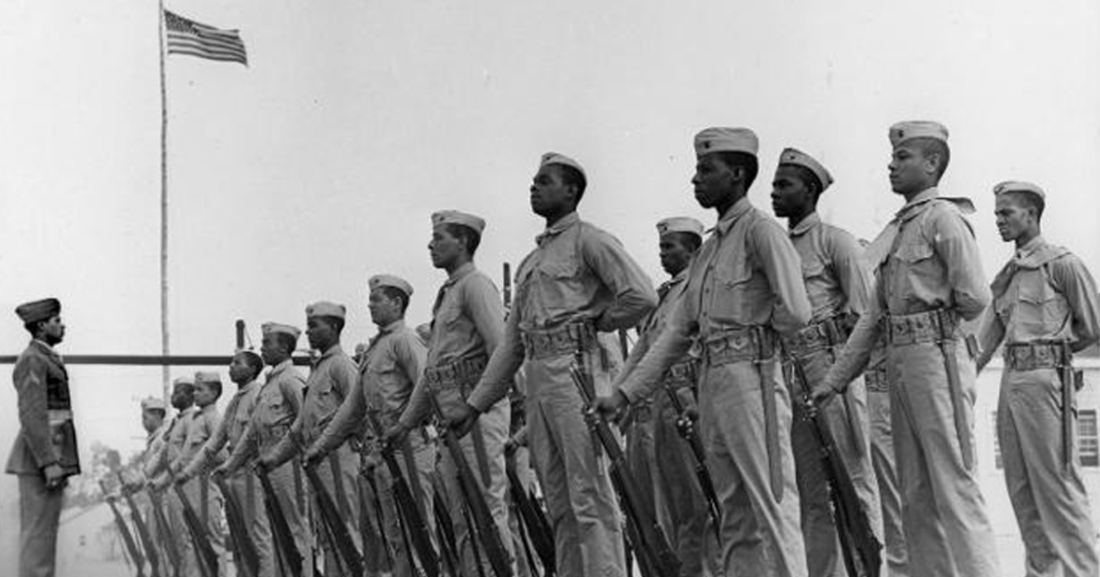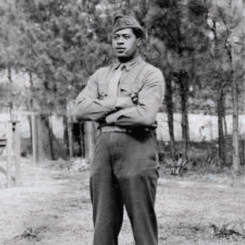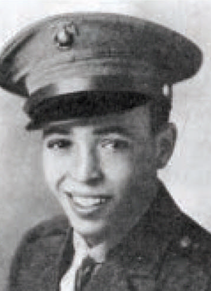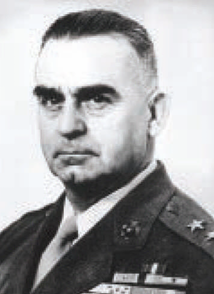NOTE: This post has been adapted from an article previously published in Leatherneck Magazine.
 GySgt Perry Fischer
GySgt Perry Fischer However, serving in administrative and ceremonial duties in Washington, D.C., was not what he had wanted. Like many Marines, Fischer yearned to do his part and be closer to the fighting.
With no previous knowledge of the unit to which he had been assigned, GySgt Fischer could not conceal his surprise upon arrival at Montford Point. Black Marines marching up and down the parade ground outside his new command was almost the last thing he expected to see. He wondered aloud to his fellow white enlisted staff if he was being punished for an indiscretion of which he was unaware. Most of them had wondered the same thing. Until their new assignment, the majority of them were not even aware that African-Americans were allowed to join the Marine Corps. It seemed impossible to many that black and white Marines could work efficiently together, let alone prepare for the rigors of warfare in the Pacific.
At the start, tensions within the 8th Marine Ammunition Co were high. Black noncommissioned officers (NCOs) who had led their men through basic training had to stand by silently until they could ascertain the degree of authority their new white superiors would allow them. White staff, both NCO and officer alike, with varying levels of conviction, made mistakes in attempting to gain their men's trust. Slowly but surely, however, men like Fischer and the rest of the unit began to embrace the Marine Corps' unifying spirit of discipline and pride. Despite fears from both sides, the Marines at the small-unit level started to see beyond racial differences and recognized each other as comrades in a common cause. Their duty, not their color, came to be what truly mattered.
Since opening its doors on 10 Nov. 2006, the National Museum of the Marine Corps' mission has been to honor the commitment, accomplishments and sacrifices of all Marines. In order to appreciate better the diversity accomplishments of the Marine Corps today, we have to look historically at how we began such integration. Through current exhibits and in the coming galleries, the National Museum of the Marine Corps, located in Triangle, Va., near the Quantico Marine base, is dedicated to presenting the history of diversity.
Examining the legacy of the Montford Point Marines within the rich history of WW II provides inspiration and a greater understanding of the path our country took to diversity. The honoring of WW II black Marines with the Congressional Gold Medal and the interest expressed in their history by then-Commandant, General James F. Amos, served to highlight how the military led social and cultural integration within the wider American experience. The Museum proudly assists that effort by highlighting not only the great battles and figures of Marine Corps history, but the key moments (both high and low) of the men and women who helped build the present day Corps.
While touring the Museum's WW II gallery, visitors become immersed in the Marine Corps' greatest military struggles and victories. The inspiring narrative focuses primarily on the Pacific War, but there are many other inspirational stories to tell. One such display recognizes the Montford Point Marines. Enhanced interactive exhibits highlight rarely seen archive images of black Marines during the war. A selection of compelling oral histories educate museum visitors about how an all-white, all-male Marine Corps entered America's greatest war and emerged socially and culturally transformed-beginning to resemble the Marine Corps of today.
Starting with wartime expansion and the Corps' first significant acceptance of African-American Marines, the Museum's exhibits explore the genesis and tribulations involved in the progression of African-American recruits, from the humble origins of segregated life at Montford Point to the battlefields of Saipan and Iwo Jima. African-American Marines originally were assigned to ammunition and supply units as a means of enforcing segregation, and a Museum exhibit highlights the significant contributions they made to those support units and their valor in combat.
Current story lines commemorate the important contributions of the Women Marine Reserve to the war effort. Enhancements to the Iwo Jima and Okinawa exhibits note the important strides made within the Corps for Marines of Hispanic heritage and the service of Native Americans in WWII.
While the level of individual achievements and struggles may have varied in light of the enormous size and scope of WW II, the history of those Marine diversity pioneers is a vital and inspirational story.
Muster and payrolls from the Revolutionary War indicate at least three black Americans served in the Continental Marines. Their brief efforts in pioneering diversity quickly were lost to the past. On 25 May 1942, the Commandant of the Marine Corps first issued formal instructions to recruit "colored male citizens," and the course of history was altered significantly. The Commandant's order came with reservations. In March 1943, Classified Letter of Instruction No. 421 stated in stark terms the types of challenges facing black Marines. Clearly showing they would not be accepted as equals, the order bluntly stated that "in no case shall there be colored noncommissioned officers senior to enlisted men in the same unit." The Commandant's previous declarations that blacks were "trying to break into a club that doesn't want them," and his preference that they "satisfy [their] aspirations for combat in the Army," left little doubt about the official attitude of the Marine Corps.
Confronted with the prevalent mindset of the era, the black Marines of Montford Point found inspiration and solidarity within their own ranks. Ably led by a hastily assembled cadre of noncommissioned officers such as Edgar R. Huff and Gilbert H. Johnson, they persevered in the face of internal and external prejudice. In the 1993 book "Blacks and Whites: Together Through Hell," author Perry Fischer (with co-author Master Gunnery Sergeant Brooks Gray) documents his wartime experiences and how he learned to take great pride in being selected to lead black Marines with the 8th Marine Ammunition Co. As one of only 144 white Marine noncommissioned officers selected
from the entire Marine Corps to lead black Marines, Fischer learned to see the potential in his assignment and men. When viewed in the difficult context of the time, their book is a remarkable inspiration.
Camaraderie at the unit level would serve the segregated Ammunition and Depot Co Marines well in the Pacific. Intended to serve as a source of labor, but never in direct combat, the realities of the war in the Pacific proved otherwise for black Marines. The units saw action at Saipan, Tinian, Guam, Peleliu, Iwo Jima and Okinawa, and they served with pride and valor both in combat and support roles. Accepted reluctantly under the needs of wartime expansion, each of the four black Marine companies present at Iwo Jima was cited for exceptional bravery and service under fire.
They were led by pioneers such as Colonel Julia Hamblet. Among the first to enter the ranks of the Women Marine Reserve in 1943, Hamblet had an impressive career spanning 22 years. When she retired in 1965, she had served two times as the Director of Women Marines. Like black Marines, women Marines rose above the questioning at the highest levels of their service and were forerunners of the Marine Corps of today.
Perceptions of ethnicity in the Marine Corps during WW II also changed. Interspersed among white units, Marines of Hispanic heritage fought in every major battle in the Pacific theater. Among their greatest stories was that of Medal of Honor Marine PFCs Harold Gonsalves. A hardened Marine veteran at the age of 19, PFC Gonsalves sacrificed his life for his fellow Marines when he flung himself on an enemy grenade during the Battle of Okinawa.
At the higher levels of command, Pedro del Valle became the first Hispanic-American general in the Marine Corps in 1942. A distinguished combat officer at Guadalcanal and Guam, Lieutenant General del Valle was awarded the Navy Distinguished Service Medal in recognition of his leadership as the commanding general of the 1st Marine Division during the Battle of Okinawa.
From the beginning, the Marine Corps' story has been one of transformations. From a small force of ship borne detachments to the modern-day Marine expeditionary units, the mission and scope of the Corps is constantly evolving. While Marines of every era enjoy a sense of continuity and camaraderie in their title, the concepts of those who were allowed to enter this realm have changed.
Today, the United States Marine Corps is composed of men and women of every place and creed and is representative of the diversity of the American people. Considering the Marine Corps' pre-1942 segregated history and the demographics of minorities and women proudly serving today, this is an amazing accomplishment: one that makes a strong argument for the U.S. Armed Forces as the true "melting pot" of American society.
As the WW II generation passes on, there is a risk of their history being lost. If you have artifacts, photos or papers you would like to preserve within your family or donate to the museum, to learn how, visit the Artifact Donation page.
Authors: Owen Conner and Charles Grow
Owen Conner is a Uniforms and Heraldry curator at the National Museum of the Marine Corps, specializing in World War II history. Charles Grow is a retired Marine captain and combat artist and former deputy director of the National Museum of the Marine Corps.









 RSS Feed
RSS Feed







